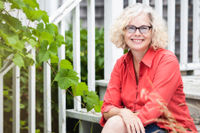By Lezlie Lowe |
Lorraine Vassalo looks out her office window beyond the brackish Avon River toward the expanse of North Mountain. Around her on the Avon Peninsula sprawl 23 bountiful acres of grape vines. This is no small scene. But it’s the top-half of the portrait that really makes it—the sky. Today, a calm grey stippled with darker streaks.
“Remarkable” is one word Vassalo has for it, a view tremendous enough to inspire the name of her business and second career—Avondale Sky Winery.
It was in 2008, after retiring from a career with the provincial government, that Vassalo and her husband, Stewart Creaser, leapt into the wine business. Despite a shared passion for all things red, white, and rosé, buying a vineyard was a personal and professional stretch—like nothing either of them had done before.
Vassalo’s 1990 Masters of Business Administration in finance helped, especially the focus on entrepreneurship. Owning a winery “was something that really grabbed us,” she says. “Whether you succeed or fail, it’s on you.”
An unanticipated and welcome upshot of the first eight years of making wine has been the opportunity for a sort of perennial education for the pair. “It’s learning forever,” she says. “It’s our hope we can do it into our 80s.”
Avondale Sky is off Exit Five on Highway 101. Vassalo can’t see the gaggle of other wineries clustered along Nova Scotia’s Annapolis Valley. But her competitors and comrades are never far.
In her cellar, Vassalo has some riddling racks (that hold sparkling wines on an angle, cork-down, to finish the aging process) owned by Benjamin Bridge vineyards, four exits down Highway 101. She borrowed them to help make Avondale’s sparkling varieties. It’s hardly a cup of sugar from the next-door neighbour, but it speaks to the Nova Scotia wine industry’s co-operative spirit.
And it goes both ways. Vassalo generously loans out Avondale’s equipment, too. “At some point, our mechanical leaf plucker—which is quite an expensive piece of equipment that we only need two days a year—will go off to someone else. It saves them from having to buy it.”
The Nova Scotia wine industry passes around much more than gadgets. When a competitor extends its tendrils to Vassalo looking for technical or market help, someone at Avondale Sky always answers the query.
Sharing, Vassalo says, is “what we’re about.” The 57-year-old Cape Breton native credits this impulse to her time in the Saint Mary’s MBA program. There, students were encouraged to share knowledge and information, in the same way Vassalo does now to help grow the Nova Scotia wine industry. “It’s co-operative, not competitive. And that’s how you succeed in life.”
Claudia De Fuentes has seen firsthand the connection and collaboration that’s taken root in the Nova Scotia wine industry.
The Saint Mary’s Faculty of Management associate professor studies the correlation between knowledge sharing and success.
She presented a paper in 2012 at the Canadian Council for Small Business and Entrepreneurship conference in Halifax, looking at the formal and informal networks curling their way around Nova Scotia’s vineyards.
De Fuentes chuckles telling the story of interviewing one winemaker for her research and seeing the same winemaker again at her next interview. He was driving by to confirm a dinner date with the second winemaker. They had already arranged childcare so everybody could make it.
Dinner parties are a hint of the underlying networks that allow this industry—whose 2015 sales reached $15.4 million—to flourish. De Fuentes says those informal connections help build trust, which allows formal industry and business networks to function better.
“Of course, they have their secrets,” she says, “but they are very open.”
While an inclination toward total competitive secrecy seems common—if not downright necessary—in business, the Nova Scotia winemakers De Fuentes has studied abide largely by a different understanding: sharing correlates with success. And based on her research, that goes both for businesses sending out information and for those on the receiving end; equally for technical know-how and market smarts.
“The most important thing is to be connected.”
The result? “If wines from Nova Scotia are widely recognized,” De Fuentes says, “they are just going to get more customers.”
De Fuentes is familiar with similar knowledge networks at play in more traditional and heavier-hitting wine regions in Chile, South Africa, and Italy. When she moved to Halifax in 2011 to join the Sobey School of Business, she discovered Nova Scotia’s small but mushrooming industry.
Today, there are close to 20 wineries in Nova Scotia, most clustered in the Annapolis Valley. In May, the province announced a $3.5 million investment to grow the industry and its national and international reach. Another $8 million will follow over four years.
“Whenever I go to the NSLC, I try to buy at least one Nova Scotia wine,” De Fuentes says. “And most of them are good.”
Indeed. It seems that knowledge sharing among wineries is bearing fruit as our province’s wines—once passed off (let’s face it) as weak and unworthy—routinely sell out and win awards beyond provincial and national borders.
“If wines from Nova Scotia are widely recognized, they are just going to get more customers.”
In July, Avondale Sky garnered one of three Lieutenant Governor’s Awards for Excellence in Nova Scotia Wines, along with Lightfoot & Wolfville Vineyards, and Gaspereau Vineyards (owned by another Saint Mary’s MBA graduate, Carl Sparkes). In the Tasters Guild International Wine 2016 judging, Avondale Sky was awarded six silver and two gold medals.
It is perhaps no shock that De Fuentes’s research found that the winery that shares its market know-how and technical knowledge with the greatest number of other wineries is … you guessed it … Avondale Sky.
Vassalo almost shrugs off her company’s evident aptitude for sharing. For her, elevating the entire industry through collaboration is nothing more than a rising-tides-lifts-all-boats move.
“If there’s only one great winery in Nova Scotia,” she says, “then the Nova Scotia wine industry is not so great.”
Luckily that’s not the case.
The rubber really hits the road with all this networking when it comes to Tidal Bay, Nova Scotia’s first geographically defined and juried wine. Just like Scotland has Scotch and France, Champagne, Nova Scotia now has Tidal Bay, an aromatic light white wine that pairs well with seafood. “It goes with what it grows with,” Vassalo rhymes.
A wine can only be called Tidal Bay if it’s grown with Nova Scotia grapes of certain varieties and meets an extensive set of standards. Each winery’s Tidal Bay tastes a little different than its neighbours’. And each one must pass the test of a tasting panel. Failing doesn’t mean the wine is no good; it simply doesn’t meet the tight criteria necessary to be called Tidal Bay.
Creating the standard for the Tidal Bay was no small effort. To lead it, the Winery Association of Nova Scotia brought in top-tier Canadian winemaking consultant, Peter Gamble.
“He showed us what we could do best,” Vassalo says. (She should know: it was Avondale Sky’s 2015 Tidal Bay that won that Lieutenant Governor’s Award in a blind tasting.) But the real key was having Nova Scotia winemakers come together and agree on what this wine should smell, taste, and feel like.
“It’s a really good example of sharing knowledge, reaching consensus, and sharing best practices,” De Fuentes says. “They were able to discuss and come to agreement on the aspects of one product.”
Vassalo remembers a family dinner when she was a child. She was taking little sips of one of her uncle’s wines.
“It would taste one way, and then I would reach over and have another sip 15 minutes later and the wine tasted different. It evolved in the glass.” She was hooked.
“Wine has been a passion of mine for closing in on 50 years.”
This love saw her bike and sip her way through Europe’s wine regions, but it wasn’t until she closed the door on her civil service career that Vassalo seriously considered an involvement in the wine industry herself.
Owning a winery is no flight of fancy or simple money-making scheme—the industry is subject to the testy temperaments of weather, sometimes oppressive regulation, and up to a decade between investment and return.
“We could have bought a really big boat and gone to the Caribbean,” Vassalo says. “And there is nothing wrong with that. But, we wanted to give back to Nova Scotia.”
Instead of the Caribbean boat dream, they floated a barge with an about-to-be-demolished church down the Minas Basin and along the Avon River. This refurbished church—now their main winery building—served as the launching pad for Avondale Sky.
And since then, Vassalo has fulfilled her wish to give back.
She and Creaser have hired locally, giving people a chance to stay in the province, close to their families. They’ve given young Nova Scotians an opportunity to gain work experience and complete co-ops. And they’ve also helped to grow an established and uniquely Nova Scotian industry by sharing riddling racks and mechanical leaf pullers, by trading knowledge, and even by looking after each others’ kids.
“You work with other people. You don’t see other people as competition. Even if the same business is next door. If we had three other wineries next door, we would be thrilled,” Vassalo says. “It’s community.”




